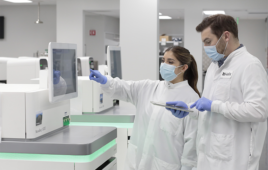Pharmacogenetics rules the R&D landscape at some drug companies and this ever-evolving science is keeping its players quite busy.
 Pharmacogenomics and pharmacogenetics are used interchangeably and no consensus has been made to distinguish them. In general, however, pharmacogenetics is aimed at understanding how the response to a drug can be affected by an individual’s genotype. Pharmacogenetics deals with drug targets on the DNA level in the form of one or a few genes, whereas pharmacogenomics—the application of genomics technologies to drug discovery—looks at the entire genome. Drug developers look to these approaches to maximize response to their therapeutic molecules.
Pharmacogenomics and pharmacogenetics are used interchangeably and no consensus has been made to distinguish them. In general, however, pharmacogenetics is aimed at understanding how the response to a drug can be affected by an individual’s genotype. Pharmacogenetics deals with drug targets on the DNA level in the form of one or a few genes, whereas pharmacogenomics—the application of genomics technologies to drug discovery—looks at the entire genome. Drug developers look to these approaches to maximize response to their therapeutic molecules.
Pharmacogenetic research at Johnson & Johnson Pharmaceutical Research & Development, L.L.C. (J&JPRD), Raritan, N.J., is applied to a number of different therapeutic areas including metabolic disorders, central nervous system disorders, and oncology. Building this program took many years and involved developing an infrastructure including, among other things, a biobank and a genotyping facility, but also data management and bioinformatics capabilities. “Developing this program also involved working with our regulatory authorities and following the guidelines that they have released on the regulation of pharmacogenomics in R&D,” says Nadine Cohen, PhD, head of pharmacogenomics and senior research fellow, J&JPRD.
A vision …
A major goal of the pharmacogenetic approach is to reduce adverse events and increase efficacy of new and existing drugs. And by designing drugs that are optimized to treat a smaller population of patients that share the same genotype for the drug target, scientists are getting closer to this goal. The results also include addition of this genetic information to the drug label that is approved by the FDA for the specified indication.
The pharmacogenetic approach is used for almost every compound J&JPRD develops now. As part of these efforts, J&JPRD systematically collects and then stores DNA samples from patients that participate in the clinical trials. This DNA is genotyped for genetic markers within genes encoding proteins involved in drug metabolism, drug mode of action, or disease predisposition. J&JPRD then searches for relationships between genetic variability and clinical variability.
This might allow J&JPRD to generate information about a mechanism of action or dosing of a drug to be placed on the drug’s label. For example, J&JPRD has collected and stored approximately 10,000 DNA samples from patients participating in the clinical trials for two central nervous system drugs. “And the number of samples is key to a genetic analysis. So we are looking for markers of response and adverse events in this area, so that it could benefit our current compounds but also generate information to be used in the development of backup compounds,” says Cohen.
Although their pharmacogenetics infrastructure includes an extensive genotyping and biobanking facility, J&JPRD does outsource most of their genotyping work to biotech-based genotyping services, which tends to be efficient and cost-effective. However, they also develop genotyping assays that “cannot be easily outsourced.” For instance, pre-screening of patients prior to their inclusion or exclusion from clinical trials based on their genotype, a process that must be performed within one to three days, is generally performed in house.
Pharmacogenetic and pharmacogenomic experiments are notorious for generating enormous amounts of data. And although there are bioinformatics tools to tame the savage data monster, data interpretation is still a concern, especially when trying to narrow down a list of potential gene variants to one or a few clinically-actionable ones. Cohen identifies this as a challenge. She also points out that identifying a genetic marker that is a strong enough predictor of drug response is a challenge to developing a companion diagnostic for a drug.
Says Cohen: “A vision I have in the next few years is that we’ll in fact have sequence generated for any individual we work with, thanks to progress in next generation sequencing. So the big challenge we see now is not solely the design of the clinical studies and the careful definition of the phenotypes but the analysis of the data and the interpretation of the data. How are we going to store this massive amount of data? And how are we going to come up with signatures of markers—sequences clinically- actionable and truly predictive of drug response and adverse events? Will this lead to truly targeted therapies and drugs linked to a companion diagnostic?”
Biomarker discovery plan
As part of his responsibilities as executive director of medical sciences at Amgen, Scott Patterson, PhD, is charged with ensuring as many potential drug molecules going into man have associated biomarkers to inform their early development and help in their transitioning to late-stage development, a process which begins years ahead of first-in-man studies with the development of a biomarker discovery plan. “We can use a range of platform technologies including microarray platforms from Agilent, Illumina, and Affymetrix, for example; high-throughput TaqMan; branched DNA; as well as various proteomics technologies,” says Patterson. But of course, these are only tools used to accomplish the ultimate aims of these studies: understanding the impact of a novel therapeutic on the biology of a cell signaling pathway and identifying appropriate biomarkers to measure the inhibitory effects of that therapeutic on those pathways in man.
Amgen’s biomarker discovery process involves three major components. The first component is to understand at a biochemical level the candidate drug’s impact on the target pathway as designed. These studies rely on molecular biomarkers and utilize the aforementioned array and amplification-based technologies. “Of course, we have to translate those technologies from the broader-based discovery method into methods that can be employed in the clinic, which is exciting but challenging because the technologies and reagents required for performing those assays aren’t necessarily suited or originally designed for the kind of robustness that is required for clinical studies.” By taking that biochemical information to construct exposure-response relationships for a given biomarker—the second component of biomarker discovery—Patterson’s group may help guide dose-ranging studies. “We don’t read out the dose directly but it helps narrow the dose range that can then be explored clinically,” he says. The third component—patient stratification—only begins to be explored in Phase 1 studies and continues to be studied as the molecule progresses through late-stage development.
Patterson’s group uses a mixture of pharmacogenetic and pharmacogenomic methods for their drug discovery and development research. For the most part, they look at single nucleotide polymorphisms (SNPs) and copy number variations (CNVs) for pharmacogenetic studies. “In discovery efforts, the SNPs may be able to point to genes that are more highly correlated to a particular disease type that might represent a target or provide confirmation of a target that you are working on.”
Although the resolution of their current pharmacogenetics platform is high enough for looking at SNPs, they are looking to improve it to look at smaller changes such as insertions and deletions through the application of NextGen sequencing approaches. The pharmacogenetic approach allows them to determine if those genetics differences are impacting the biology of treatment response to the drug under study. “If we knew the biology that we are trying to interdict perfectly, and we knew how our drug worked perfectly, then we wouldn’t have to use these [platforms] because we’d know what to measure,” says Patterson. “But of course, that is not the case. And you actually gain an increasing understanding of the biology that you are trying to treat through the drug development process.” And what is learned may be translated into the development of a companion diagnostic for the developed drug.
Consultation, por favor
Allen D. Roses, MD, who once ran the pharmacogenetics group at GlaxoSmithKline, and is currently professor of medicine (Neurology) and director, Deane Drug Discovery Institute, Duke University, Durham, N.C., also heads up his own pharmaceutical consulting company called Cabernet Pharmaceuticals. The company offers pharmacogenetic pipeline consultation to pharmaceutical and biotech companies. “For companies who have a fairly large pipeline like one of the top 10 pharmaceutical companies, a number of [our consultants] will be unique just for their pipeline. And for some of the smaller biotechs that only have one to three clinical projects, then those consultants can handle a couple of that size, usually in a couple of different therapeutic areas,” says Roses.
In addition to consulting for the pharm-biotech industry, Roses is also involved in research due to his position as director of the Deane Drug Discovery Institute. In this role, he and his colleagues look to help academic investigators at Duke University to progress promising potential therapeutics along the drug discovery pipeline. One project he is currently working on aims to identify genes other than ApoE4 that might be predictive of Alzheimer’s disease age of onset, and then to apply that knowledge to developing an Alzheimer’s disease prevention trial. Although all of the lab work for this project is outsourced, Roses is accountable for the design of these experiments.
In that design process, the pharmacogenetic studies performed by Roses and colleagues implement both candidate gene and whole genome approaches. “For companion diagnostics where, for efficacy, you might have 5,000 to 10,000 patients in the Phase 3 drug trials, you might supplement the initial candidate gene associations with whole genome approaches. The critical thing is to know how to do it,” says Roses. “We are also in discussions with some of the generic drug companies who want to evaluate the competitive advantage that they might develop by having a pharmacogenetic companion diagnostic with their generic, something that the big companies will not do post-exclusivity. Continued reimbursement could require a companion diagnostic; then the generic company may have a newly-patented test to support their use. This requirement seems implicit in the FDA’s recent label changes for warfarin.”
This article was published in Drug Discovery & Development magazine: Vol. 11, No. 11, November, 2008, pp. 26-28.
Filed Under: Genomics/Proteomics



